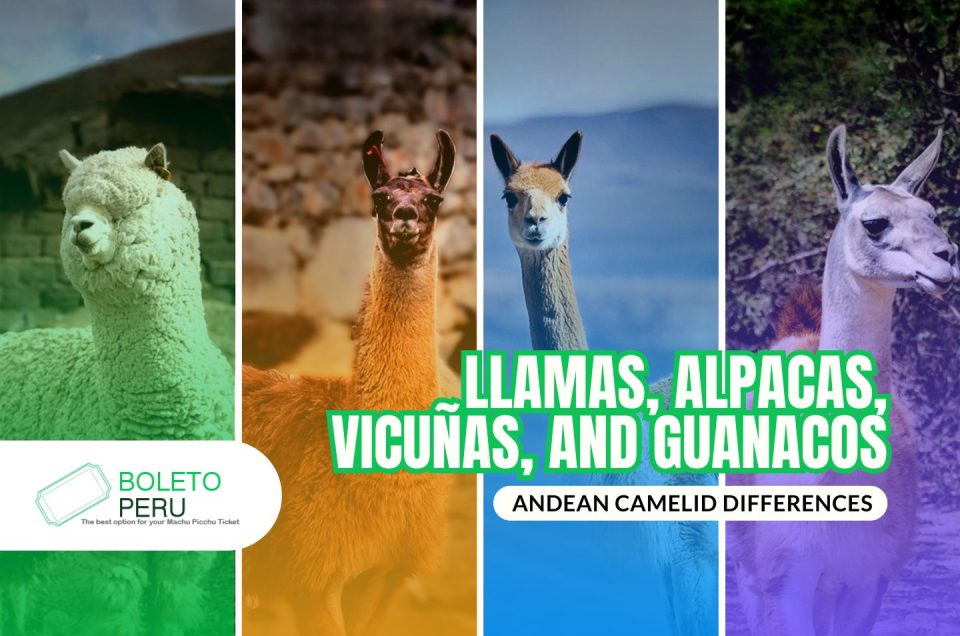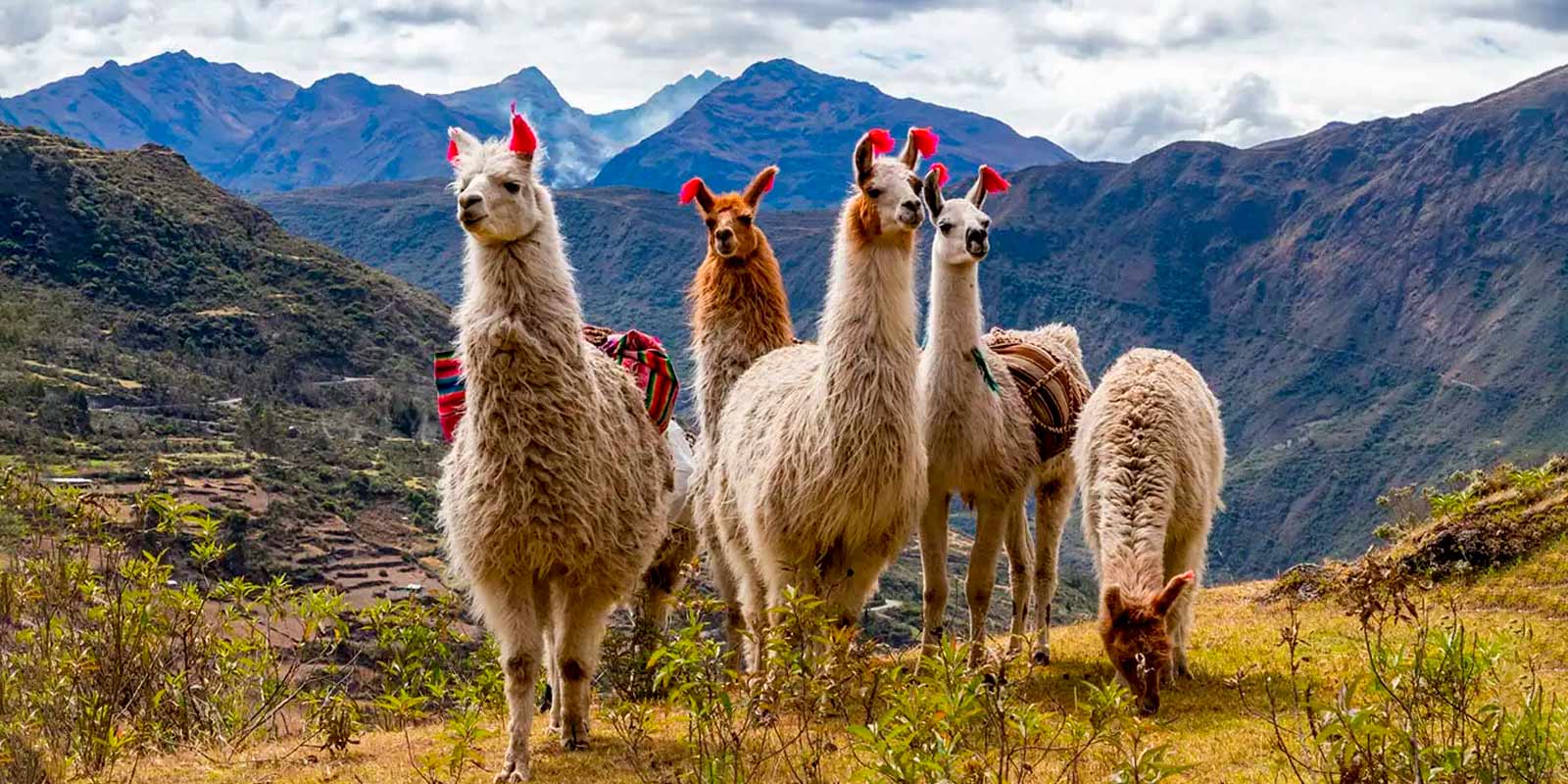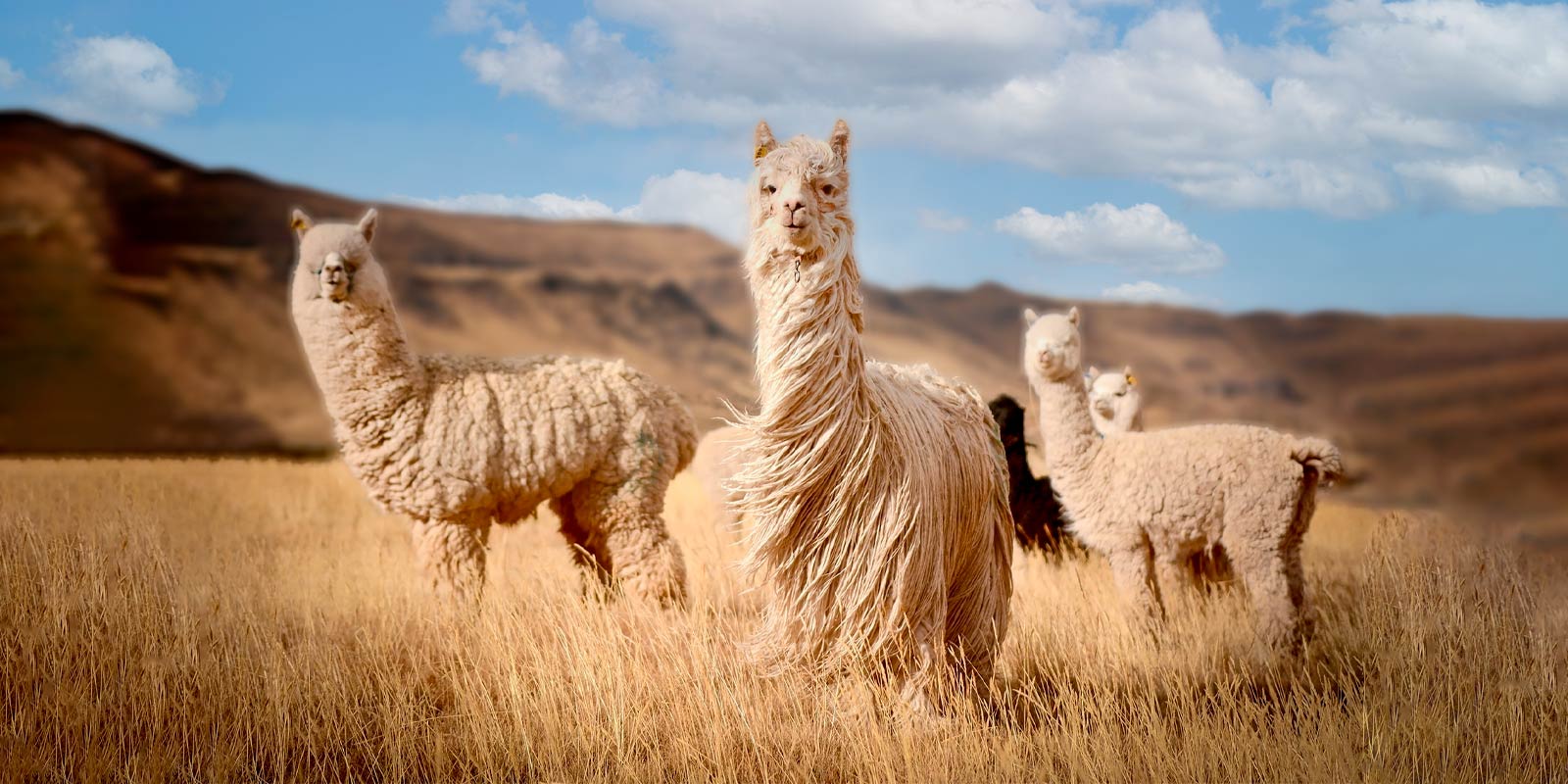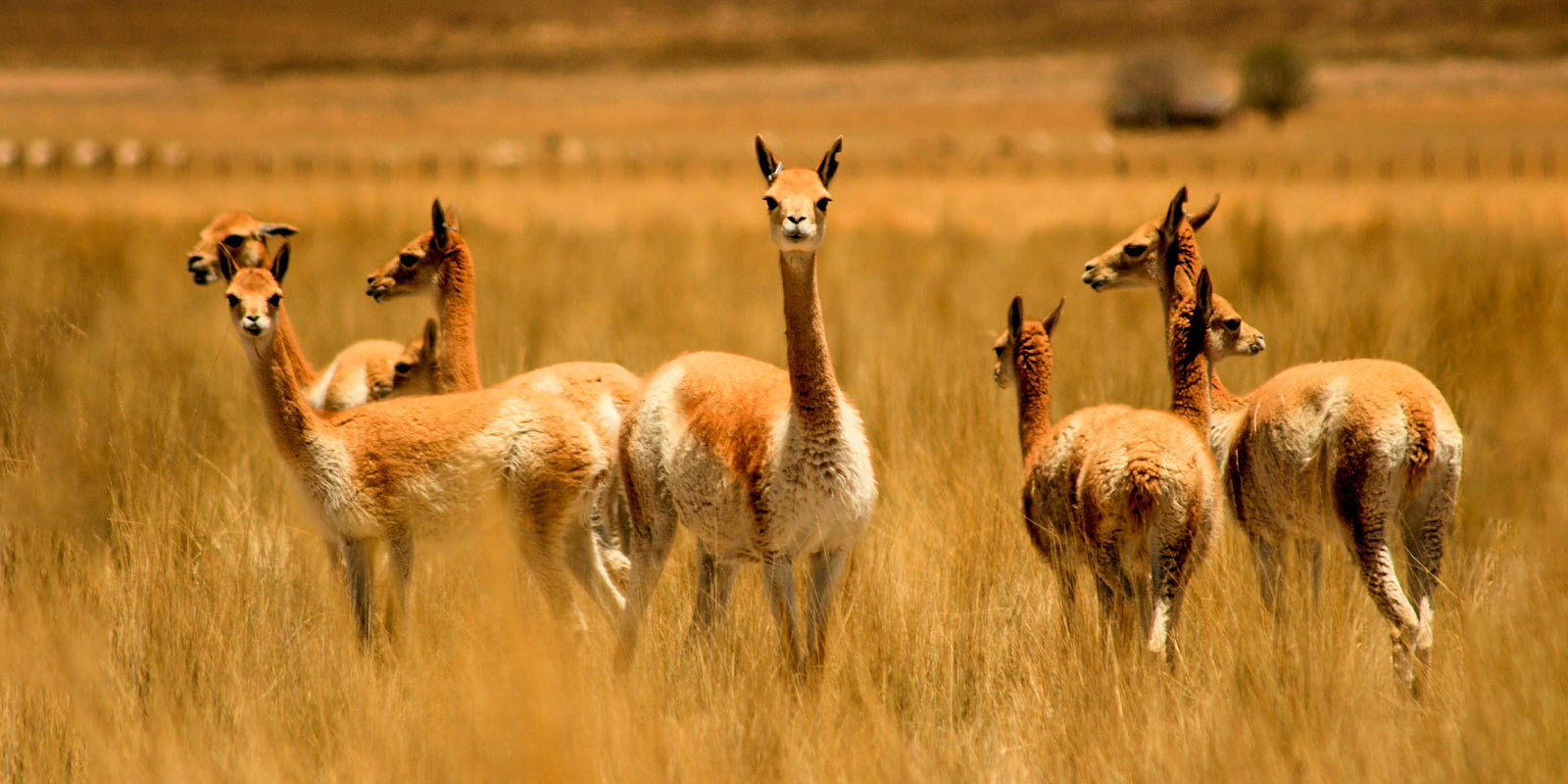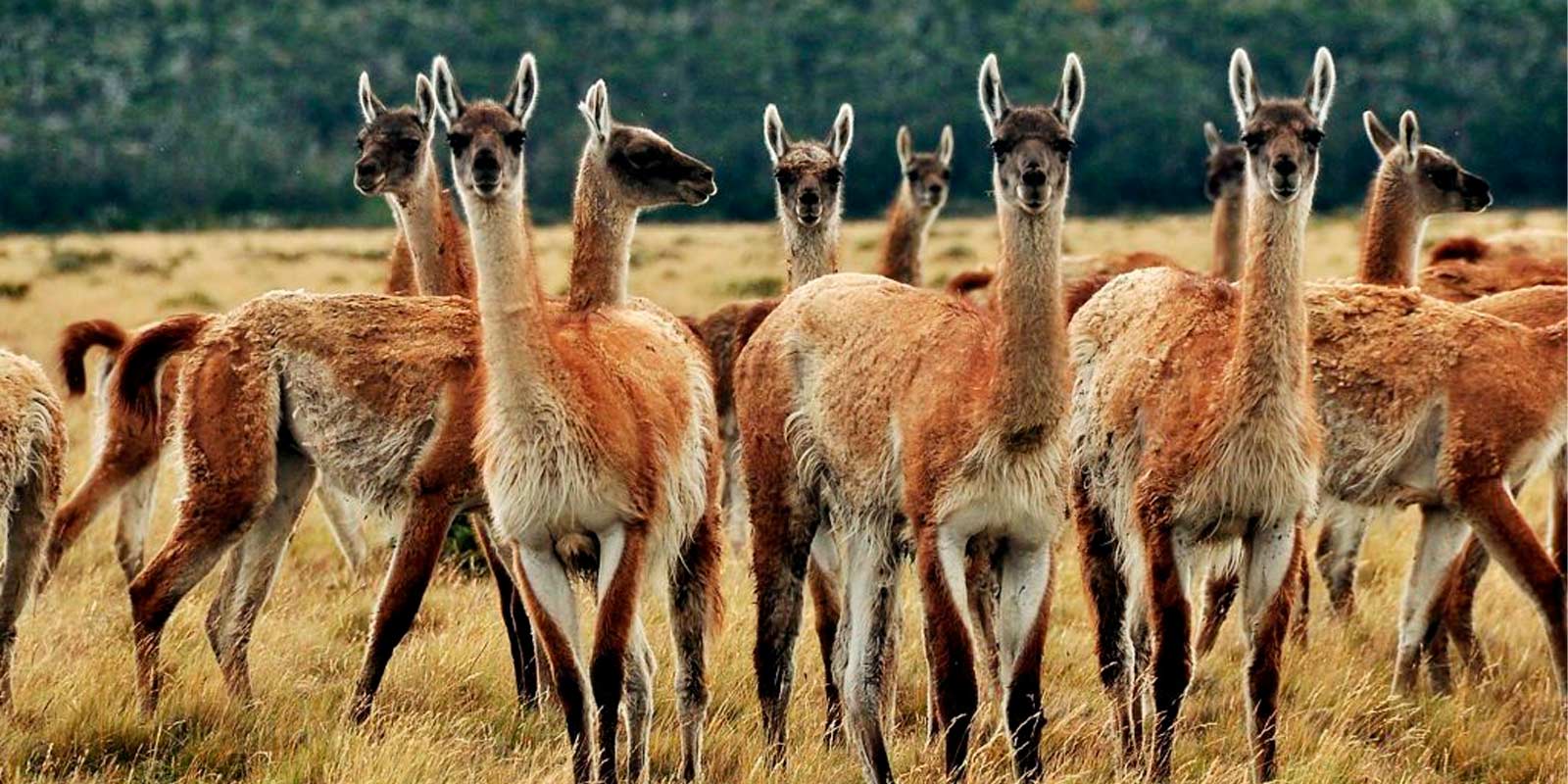High in the Andes of the Cusco region, where the air is thin and the land is wide, lives a group of unique animals deeply connected to the history and culture of South America: the Andean camelids. Llama, alpaca, vicuña, and guanaco share a common ancestor and many physical similarities, but each one has very different features, behaviors, and roles in the societies around them.
Since before the Incas, these animals have been an essential part of life in the Inca culture. They have been used as a way to travel, a source of warmth, food, and cultural wealth. The Andean civilizations not only depended on them economically but also honored them as sacred symbols of the connection between humans and nature.
At first glance, they may look the same to someone who doesn’t know them well, but learning their differences is discovering a fascinating world of adaptation, evolution, and living together with the environment. In this blog, we will explore each of these camelids in depth to learn about their history, characteristics, and the uses they have had.
The Llama: The Carrier of the Andes
The llama (Lama glama) is one of the first animals tamed in South America. It is thought that its taming happened more than 4,000 years ago in the high Andean regions of what is now Peru and Bolivia, from the guanaco, its wild ancestor. Since then, llamas were very important for the pre-Inca societies and especially for the Inca Empire, which used them as load animals in big groups that crossed the road system known as the Qhapaq Ñan. Their value was not only useful, but also symbolic: in some religious rituals (like in the Inti Raymi), llamas were offered in ceremonies to honor the Andean gods, especially Pachamama (Mother Earth).
Physical and Behavioral Traits
- Llamas are the biggest tamed camel-like animals in South America, reaching up to 6 feet tall (counting the head) and weighing between 285 and 440 pounds.
- They have long ears shaped like bananas, a long head, long neck, and thick fur that can be different colors from white to dark brown or spotted.
- Behavior-wise, they are social animals that live in groups with leaders, usually a dominant male. Even though they are usually calm, they can spit as a way to defend themselves or to show who is in charge in the group.
- They are very strong in the extreme conditions of the Andes and can travel long distances with little water and food.
Traditional and Current Uses
The main job of the llama has been as a pack animal. For centuries, it has carried goods through the Andes of Peru, being especially helpful in rough lands where other animals cannot go. Also, even though its wool is not as fine as alpaca wool, it has also been used to make thicker fabrics like blankets and ropes.
In some Andean communities, llama meat is part of the local diet, and it is eaten in traditional dishes like charqui (dried meat). Today, llamas also play a role in rural tourism: many communities offer experiences where visitors can walk with them or learn about their raising and their role in Andean culture, and it is even common to see them wandering among the ruins of Machu Picchu.
The Alpaca: The Queen of Fine Wool
The alpaca (Vicugna pacos) is another of the domesticated camelids of South America and comes from the vicuña, its wild relative. Its domestication goes back more than 3,000 years, mainly in the highlands of Peru and Bolivia. Since then, the alpaca has been valued for the very high quality of its wool, considered one of the finest and warmest natural fibers in the world.
In the times of the Inca Empire, alpaca wool was a valuable resource reserved for the nobles and used to make ceremonial clothing. Alpacas also had an important role in farming rituals and religious festivals. Over time, their raising has remained an essential activity in the high Andean communities, both for their economic value and for their cultural meaning.
Characteristics and Types of Alpaca
Alpacas are smaller than llamas, with an average weight between 120 and 140 pounds, and a height of about 3 feet at the shoulder. They have shorter and pointed ears, a flatter face, and a more compact body. Unlike llamas, they are not used as pack animals.
There are two main types of alpacas:
- Huacaya: This type is about 90% of all alpacas. It has a wool that is fluffy, curly, and thick, which makes it look soft. It is the most common type on the high plains.
- Suri: This type has a wool that is longer, silky, and shiny, falling in straight locks that look like dreadlocks. Its fiber is less common, but very valued for its feel and how rare it is.
Uses of alpaca wool
The main value of the alpaca is its wool. Its fiber is light, strong, doesn’t cause allergies, and is warmer than sheep’s wool. It is used to make fancy clothes like scarves, sweaters, shawls, and blankets, which are sold both in Peru and other countries.
For many Andean communities, raising alpacas is the main part of their rural economy. Through groups and craft fairs, the families that raise alpacas not only sell the fiber but also handmade products. Also, alpacas have become something that brings experiential tourism, letting visitors see up close the process of shearing, spinning, and traditional weaving. You can often see them around the Cusco region, especially on high-altitude routes like Ausangate and Rainbow Mountain.
The Vicuña: Wild Treasure of the Andes
The vicuña (Vicugna vicugna) is the smallest and most delicate camel-like animal of the Peruvian Andes, and at the same time one of the most valuable. Unlike the llama and alpaca, the vicuña was never fully tamed. During the Inca Empire, it was seen as a sacred animal and only the elite could wear clothes made with its wool. The Incas set up community management systems to protect them, allowing their shearing only in special ceremonies called chakus, which were done in a ritual and respectful way.
With the arrival of the colonizers and the later stopping of these traditional practices, the vicuña population fell sharply due to uncontrolled hunting for its wool. In the middle of the 20th century, it was close to disappearing, with less than 10,000 in the wild. However, thanks to conservation rules, community efforts, and protected natural reserves, today the vicuña has managed to recover and they are protected species and hunting them is strictly forbidden by Peruvian law. Also, it is a symbol of ecological preservation in Peru and other Andean countries.
Characteristics and Habitat
- Vicuñas are slender, move quickly, and are very cautious.
- They weigh between 77 and 110 pounds and have short, fine, light golden fur on their backs, with a white area on their chest and belly.
- Their ears are small and straight, and they have a thinner face than their domestic relatives.
- They live in the wild in the high Andean areas, between 11,500 and 16,400 feet high, where they face extreme cold, sun, and lack of oxygen.
- They group in families formed by a dominant male and several females with their young, and they are very territorial.
Value of its wool and sustainable management
Vicuña wool is seen as the finest in the world, with fibers that measure just between 11 and 14 microns thick, which gives it amazing softness and warmth. Its rarity and how hard it is to get make its value very high in the international market, turning it into a real luxury.
Today, the shearing of vicuñas is done under strict rules of sustainable management, often using the old practice of the chaku, where communities organize the temporary capture, shearing, and release of the animal. This helps protect the species while getting a valuable resource that benefits local communities financially.
The Guanaco: The Hardy Ancestor
The guanaco (Lama guanicoe) is one of the two South American Camelids that still lives in the wild, along with the vicuña. Seen as the direct ancestor of the llama, the guanaco has lived in large areas of South America since prehistoric times, being key in the lives of the original people long before animals were tamed.
Its natural spread is wide: it goes from the high Andean areas of Peru and Bolivia to the Patagonian steppe in Argentina and Chile, adapting to dry and cold weather. Although its population has gone down in some areas because of habitat loss and hunting, there are still tens of thousands of guanacos in the wild, especially in the south of the continent.
In Peru, its presence is much smaller compared to other countries on the continent, but wild populations can still be found. Guanacos mainly live in dry and high Andean areas of the south of the country. One place to see them is the Salinas y Aguada Blanca National Reserve, located between Arequipa and Moquegua, where they share the ecosystem with vicuñas, llamas, and alpacas. Sightings have also been recorded in the Calipuy National Reserve (La Libertad) and other protected natural areas with dry weather and moderate altitude, although in smaller numbers.
Behavior and Adaptability
The guanaco is a strong, quick, and very adaptable animal. It can live in places higher than 13,000 feet above sea level, but also in dry areas at sea level. Its body is covered by thick, brown fur with white parts, which lets it handle very hot and very cold temperatures. It weighs between 200 and 300 pounds, and is about 5 feet tall at the head.
They are social animals that live in groups, either families (with one male leader and several females) or groups of single males. They have very good eyesight and hearing, which lets them see dangers from far away. When they feel in danger, they run away very fast, reaching speeds of up to 35 miles per hour, which makes them the fastest camel-like animals in the region.
Role in Andean Ecology and its Genetic Relation to the Llama
Ecologically, the guanaco has a very important role as a native plant-eater, helping to keep the balance of grassland and cold desert areas. By eating and moving around, it helps certain plants grow back and spread their seeds. Also, by being part of the food chain, it is natural prey for meat-eaters like the andean puma.
Genetically, the guanaco is directly related to the llama. In fact, the llama is seen as its tamed form, the result of a selection process done by Andean cultures more than 4,000 years ago. Even though they are related, the guanaco keeps wild features that clearly make it different from its tamed relative, especially in its more independent behavior, its less tolerance for being near humans, and the makeup of its wool, which is less used for selling.
Comparison Between the Four Camelids
At first glance, llama, alpaca, vicuña, and guanaco may seem similar: they are all South American camelids, with long necks and gentle looks. However, each one has unique features that clearly set them apart in terms of their appearance, behavior, domestication, uses, and habitat. Below, we explore these differences.
Key Physical Differences
- Size: The llama is the largest (up to 5.9 feet tall), followed by the guanaco. The alpaca is smaller and stockier, while the vicuña is the smallest and slenderest.
- Wool: The alpaca produces the most commercially used fiber, especially in its Huacaya and Suri varieties. The vicuña, however, has the finest and most expensive wool in the world, although its use is limited by its wild status. Llama wool is thicker and coarser, and guanaco wool is fine but difficult to collect in the wild.
- Ears: Llamas have long, curved ears (“banana-shaped”); alpacas, shorter, straighter ears; vicuñas and guanacos have small, pointed ears.
- Color: All can have different colors, but vicuñas have a uniform golden coat with a white belly; guanacos are cinnamon-colored with white on the belly; llamas and alpacas can be white, brown, black, or spotted.
Differences in Behavior and Domestication
- Domestication: Only the llama and the alpaca have been domesticated. The vicuña and guanaco continue to live in the wild.
- Behavior: Llamas are sociable but territorial pack animals. Alpacas are more docile, raised for their wool. Guanacos and vicuñas are elusive and fast, with strong survival instincts against predators and humans.
- Interaction with Humans: Llamas and alpacas live daily with Andean communities. Vicuñas and guanacos must be protected or monitored from a distance in natural reserves.
Differences in Uses and Habitats
Uses:
- Llama: carrying loads, meat, wool, rural tourism.
- Alpaca: luxury wool, textiles, rural economy.
- Vicuña: exclusive fiber, limited to sustainable shearing.
- Guanaco: less direct use; has ecological and genetic value.
Habitats:
- Llama and alpaca: domesticated high-Andean zones (villages, rural communities).
- Vicuña: Andean highlands between 11,500 and 16,400 feet above sea level, protected areas.
- Guanaco: arid and cold areas, such as the Salinas and Aguada Blanca National Reserve (Arequipa).
Comparison Chart
| Features | Llama | Alpaca | Vicuña | Guanaco |
| Status | Domestic | Domestic | Wild | Wild |
| Size | Big | Small | Very small and slender | Medium |
| Wool | Thick and rough | Fine (Huacaya, Suri) | Very fine and valuable | Fine, not much used |
| Ears | Long, curved | Short, pointy | Small, pointy | Small, straight |
| Main Use | Cargo, meat, wool | Luxury wool | Exclusive wool (managed sustainably) | Ecological, genetic |
| Distribution in Peru | Rural Andes | Rural Andes | High Andean reserves | South of Peru (Arequipa, La Libertad) |

